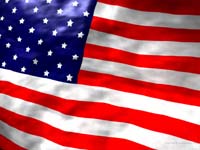U.S.A. strengthens control of airlines in response to British threat
Multiple flights to several U.S. cities also were put on alert, U.S. Homeland Security Secretary Michael Chertoff said.

It is the first time the red alert level, defined as designating a "severe risk of terrorist attacks," has been invoked in the U.S. Homeland Security warning system.
In addition to the red alert for flights from Britain, the alert for all flights coming or going from the U.S. was raised to the high, or orange, threat level "to defend further against any remaining threat from this plot," Chertoff said.
The government said it was banning beverages, hair gels and lotions from flights, explaining that liquids emerged as a risk from the investigation in Britain.
A U.S. law enforcement official said there had been no arrests in the U.S. connected to the overseas plot unraveled Wednesday evening.
Authorities believe dozens of people, possibly as many as 50, were involved or connected to the plot, a senior U.S. counterterrorism official said. The plan "had a footprint to al-Qaida back to it," the official said, speaking on condition of anonymity because of the sensitivity of the situation.
The plan involved airline passengers hiding masked explosives in carryon luggage. They were not yet sitting on a plane, but were close to traveling, the official said.
Another counterterrorism official said the investigation, which has been ongoing for months, was "very serious," and that U.S. intelligence had been working closely with the British.
It was not believed to be connected, however, to the 11 Egyptian students who disappeared in the U.S. more than a week ago before reaching a Montana college they were supposed to attend. Three have since been found, and the FBI said neither they nor the eight still missing were believed to be a threat.
Authorities have not yet arrested or detained all suspects believed to be involved in the plot, the second official said, also on condition of anonymity.
Chertoff said that, given the higher threat levels, U.S. transport authorities were coordinating with federal partners, airport authorities and commercial airlines to intensify existing security requirements.
Because metal detectors and X-ray machines cannot detect explosives, transport authorities deployed "sniffer" or "puffer" machines, which can detect explosives residue, at many but not all airport checkpoints.
Travelers should expect additional security measures at U.S. airports, but "should go about their plans confidently, while maintaining vigilance in their surroundings and exercising patience with screening and security officials," Chertoff said.
Multiple airlines with flights to multiple U.S. airports were at risk, a counterterrorism official said. Another official refused to identify the airlines because they were still being notified of the threat, but referred to them as the "usual suspects."
Subscribe to Pravda.Ru Telegram channel, Facebook, RSS!


